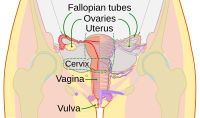
Photo from wikipedia
Objective: To investigate the clinical characteristics and perinatal outcomes of pregnancy with placental cystic lesions. Methods: A retrospective study was carried out on 48 pregnant women diagnosed as pregnancy complicated… Click to show full abstract
Objective: To investigate the clinical characteristics and perinatal outcomes of pregnancy with placental cystic lesions. Methods: A retrospective study was carried out on 48 pregnant women diagnosed as pregnancy complicated with placental cystic lesions from January 2000 to January 2020 at the Women's Hospital, Zhejiang University School of Medicine. The clinical features, pathological diagnosis and perinatal outcome were analyzed. Results: The age of 48 cases was (30±5) years, and the diagnostic gestational week of ultrasound was (24±8) weeks. Twenty-five cases in which showed a cystic mass at the fetal surface were diagnosed as placental cyst. The live birth rate was 100% (25/25) and the premature birth rate was 20% (5/25). Twenty-three cases showed "honeycomb like" cystic echo. Cystic lesions of 10 cases were located in the uterine cavity connected with the margin of the normal placenta, and finally diagnosed as hydatidiform mole and coexisting fetus (HMCF). Six cases of HMCF terminated pregnancy, and the live birth rate was 4/10, the premature delivery rate was 2/4. Cystic lesions of 13 cases were located in the placenta substance, and finally diagnosed as 4 cases of placental mesenchymal dysplasia (PMD) and 9 cases of focal chorionic edema; the live birth rate was 6/13 and the premature delivery rate was 4/6. The median hCG was lower in focal chorionic edema group [80 kU/L (60-110 kU/L)] than in the groups of HMCF [240 kU/L (180-430 kU/L)] and PMD [360 kU/L (210-700 kU/L)], and the differences were statistically significant (all P<0.01). Conclusions: For pregnancy complicated with placental cystic lesions, prenatal ultrasound should be performed to evaluate the shape, location and blood flow of the lesions. Maternal serological examination and invasive prenatal diagnosis are helpful for prenatal diagnosis and treatment. Due to the difference of perinatal outcomes, maternal and fetal complications, individualized pregnancy management should be carried out.
Journal Title: Zhonghua fu chan ke za zhi
Year Published: 2021
Link to full text (if available)
Share on Social Media: Sign Up to like & get
recommendations!